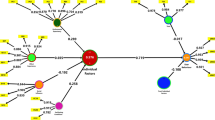Abstract
Despite the rapid growth of Internet banking (IB), customers in developing countries still hesitate to adopt this technology and its use in the Middle East remains low. This study aims to identify and examine the factors that predict behavioural intention and adoption of IB in Jordan. Four factors – hedonic motivation, habit, self-efficacy and trust – are proposed in a conceptual model. Data was collected by means of a survey with bank customers in Jordan. Structural equation modelling (SEM) was used to analyse the data. The results strongly supported the conceptual model. Further, hedonic motivation, habit, self-efficacy and trust were all confirmed to have a significant influence on behavioural intention. Trust was found to be strongly predicted by both hedonic motivation and self-efficacy. This study provides both academics and practitioners with an insight into the factors that can be used to encourage customer adoption of IB specifically in a Middle East context.


Similar content being viewed by others
References
AbuShanab, E., Pearson, M. and Setterstrom, A.J. (2010) Internet banking and customers’ acceptance in Jordan: The unified model’s perspective. Communications of the Association for Information Systems 26 (1): 493–524.
Akhlaq, A. and Ahmed, E. (2013) The effect of motivation on trust in the acceptance of internet banking in a low income country. International Journal of Bank Marketing 31 (2): 115–125.
Alalwan, A., Dwivedi, Y.K. and Williams, M.D. (2014) Examining Factors Affecting Customer Intention and Adoption of Internet Banking in Jordan. In: Proceedings of United Kingdom Academy of Information Systems UKAIS Conference, 7–9 April 2014, Oxford, UK.
Al-Gahtani, S.S. (2011) Modelling the electronic transactions acceptance using extended technology acceptance model. Applied Computing and Informatics 9 (1): 47–77.
Al-Majali, M. (2011) The use of theory reasoned of action to study information technology in Jordan. Journal of Internet Banking and Commerce 16 (2): 1–13.
Al-Qeisi, K. and Abdallah, G. (2013) Internet banking adoption in Jordan: A behavioral approach. International Journal of Marketing Studies 5 (6): 84–107.
Al-Rfou, A.N. (2013) The usage of Internet banking evidence from Jordan. Asian Economic and Financial Review 3 (5): 614–623.
Al-Smadi, M.O. (2012) Factors affecting adoption of electronic banking: An analysis of the perspectives of banks' customers. International Journal of Business and Social Science 3 (17): 294–309.
Al-Somali, S., Gholami, R. and Clegg, B. (2009) An investigation into the acceptance of online banking in Saudi Arabia. Journal of Business Research 29 (2): 130–141.
Anderson, J.C. and Gerbing, D.W. (1988) Structural equation modelling in practice: A review and recommended two-step approach. Psychological Bulletin 103 (3): 411–423.
Awwad, M.S. and Ghadi, M.Y. (2010) Investigating of factors influencing the intention to adopt mobile banking services in Jordan. Dirasat: Administrative Sciences 37 (2): 545–556.
Bandura, A. (1986) Social Foundations of Thought and Action: A Social Cognitive Theory. Englewood Cliffs, NJ: Prentice Hall.
Brislin, R. (1976) Comparative research methodology: Cross-cultural studies. International Journal of Psychology 11 (3): 215–229.
Byrne, B. (2010) Structural Equation Modeling with AMOS: Basic Concepts, Applications and Programming, 6th edn. New York: Taylor & Francis Group.
Casaló, L.V., Flavián, C. and Guinalíu, M. (2007) The role of security, privacy, usability and reputation in the development of online banking. Online Information Review 31 (5): 583–603.
Celik, H. (2008) What determines Turkish customers’ acceptance of internet banking? International Journal of Bank Marketing 26 (5): 353–370.
Compeau, D. and Higgins, C. (1995) Application of social cognitive theory to training for computer skills. Information Systems Research 6 (2): 118–143.
ComScore (2012) 1 in 4 internet users access banking sites globally, https://www.comscore.com/Insights/Data-Mine/1-in-4-Internet-Users-Access-Banking-Sites-Globally, accessed 14 August 2014.
Curran, J.M. and Meuter, M.L. (2005) Self-service technology adoption: Comparing three technologies. Journal of Services Marketing 19 (2): 103–113.
Curran, J.M. and Meuter, M.L. (2007) Encouraging existing customers to switch to self-service technologies: Put a little fun in their lives. Journal of Marketing Theory and Practice 15 (4): 283–298.
Dabholkar, P.A. and Bagozzi, R.P. (2002) An attitudinal model of technology-based self-service: Moderating effects of consumer traits and situational factors. Journal of the Academy of Marketing Science 30 (3): 184–201.
Dabholkar, P.A., Bobbitt, M.L. and Lee, E.J. (2003) Understanding consumer motivation and behavior related to self-scanning in retailing: Implications for strategy and research on technology based self-service. International Journal of Service Industry Management 14 (1): 59–95.
Davis, F.D. and Venkatesh, V. (2004) Toward pre-prototype user acceptance testing of new information systems: Implications for software project management. Engineering Management, IEEE Transactions 51 (1): 31–46.
Department of Statistics (2015) Statistical year book 2013, http://www.dos.gov.jo/dos_home_a/main/yearbook_2013.pdf, accessed: 8 March 2015.
DeYoung, R., Lang, W.W. and Nolle, D.L. (2007) How the internet affects output and performance at community banks. Journal of Banking and Finance 31 (4): 1033–1060.
Dwivedi, Y.K. and Irani, Z. (2009) Understanding the adopters and non-adopters of broadband. Communications of the ACM 52 (1): 122–125.
Dwivedi, Y.K., Choudrie, J. and Brinkman, W.P. (2006) Development of a survey instrument to examine consumer adoption of broadband. Industrial Management and Data Systems 106 (5): 700–718.
Eriksson, K., Kerem, K. and Nilsson, D. (2005) Customer acceptance of internet banking in Estonia. International Journal of Bank Marketing 23 (2): 200–216.
Eriksson, K., Kerem, K. and Nilsson, D. (2008) The adoption of commercial innovations in the former Central and Eastern European markets. The case of internet banking in Estonia. International Journal of Bank Marketing 26 (3): 154–169.
Flavián, C., Guinaliu, M. and Torres, E. (2006) How bricks-and-mortar attributes affect online banking adoption. International Journal of Bank Marketing 24 (6): 406–423.
Fornell, C. and Larcker, D.F. (1981) Evaluating structural equation models with unobservable variables and measurement error. Journal of Marketing Research 18 (1): 39–50.
Gefen, D., Karahanna, E. and Straub, D.W. (2003) Trust and TAM in online shopping: An integrated model. MIS Quarterly 27 (1): 51–90.
Cuevas, J. (1998) The internet banking horizon: Bleak or bright for community banks? Journal of Internet Banking and Commerce 3 (3): 9811–9814.
Hair, Jr, J.F., Black, W.C., Babin, B.J. and Anderson, R.E. (2010) Multivariate Data Analysis: A Global Perspective, 7th edn. New Jersey, USA: Pearson Education International.
Hall, S.D., Ray, W.E. and Knight, L.E. (1999) Using internet for retail access: Banks found lagging. Journal of Retail Banking Services 21 (1): 51–55.
Hwang, Y. and Kim, D.J. (2007) Customer self-service systems: The effects of perceived web quality with service contents on enjoyment, anxiety, and e-trust. Decision Support Systems 43 (3): 746–760.
Jaruwachirathanakul, B. and Fink, D. (2005) Internet banking adoption strategies for a developing country: The case of Thailand. Internet Research 15 (3): 295–311.
Khraim, H.S., Shoubaki, Y.E. and Khraim, A.S. (2011) Factors affecting Jordanian consumers’ adoption of mobile banking services. International Journal of Business and Social Science 2 (20): 96–105.
Kim, K.K. and Prabhakar, B. (2004) Initial trust and the adoption of B2C e-commerce: The case of internet banking. ACM Sigmis Database 35 (2): 50–64.
Kim, G., Shin, B. and Lee, H.G. (2009) Understanding dynamics between initial trust and usage intentions of mobile banking. Information Systems Journal 19 (3): 283–311.
Kim, M.J., Chung, N. and Lee, C.K. (2011) The effect of perceived trust on electronic commerce: Shopping online for tourism products and services in South Korea. Tourism Management 32 (2): 256–265.
Kolodinsky, J.M., Hogarth, J.M. and Hilgert, M.A. (2004) The adoption of electronic banking technologies by US consumers. The International Journal of Bank Marketing 22 (4): 238–259.
Kuisma, T., Laukkanen, T. and Hiltunen, M. (2007) Mapping the reasons for resistance to Internet banking: A means-end approach. International Journal of Information Management 27 (2): 75–85.
Laukkanen, P., Sinkkonen, S. and Laukkanen, T. (2008) Consumer resistance to internet banking: Postponers, opponents and rejectors. The International Journal of Bank Marketing 26 (6): 440–455.
Liao, S., Shao, Y., Wang, H. and Chen, A. (1999) The adoption of virtual banking: An empirical study. International Journal of Information Management 19 (1): 63–74.
Limayem, M., Hirt, S.G. and Cheung, C.M.K. (2007) How habit limits the predictive power of intentions: The case of IS continuance. MIS Quarterly 31 (4): 705–737.
Martins, G., Oliveira, T. and Popovic, A. (2014) Understanding the internet banking adoption: A unified theory of acceptance and use of technology and perceived risk application. International Journal of Information Management 34 (1): 1–13.
Migdadi, Y.K.A. (2012) The developing economies’ banks branches operational strategy in the era of e-banking: The case of Jordan. Journal of Emerging Technologies in Web Intelligence 4 (2): 189–197.
Riffai, M.M.M.A., Grant, K. and Edgar, D. (2012) Big TAM in Oman: Exploring the promise of on-line banking, its adoption by customers and the challenges of banking in Oman. International Journal of Information Management 32 (3): 239–250.
Rogers, E.M. (2003) Diffusion of Innovations, 5th edn. New York: NY: Free Press.
Shih, Y. and Fang, K. (2004) The use of a decomposed theory of planned behaviour to study internet banking in Taiwan. Internet Research 14 (3): 213–223.
The Gulf Today (2012) Jordan’s internet users stand at 3.535 million: 19 August 2012, http://gulftoday.ae/portal/cf77a112-4874-4abe-bba8-4265dc1aa8c9.aspx, accessed 8 January 2014.
The Jordan Times (2013) Mobile phone penetration projected to reach 200%, http://jordantimes.com/mobile-phone-penetration-projected-to-reach-200, accessed 25 December 2013.
Van der Heijden, H. (2004) User acceptance of hedonic information systems. MIS Quarterly 28 (4): 695–704.
Venkatesh, V., Morris, M., Davis, G. and Davis, F. (2003) User acceptance of information technology: Toward a unified view. MIS Quarterly 27 (3): 425–478.
Venkatesh, V., Thong, J.Y.L. and Xu, X. (2012) Consumer acceptance and use of information technology: Extending the unified theory of acceptance and use of technology. MIS Quarterly 36 (1): 157–178.
Walker, R. and Johnson, L. (2006) Why consumers use and do not use technology-enabled services. Journal of Services Marketing 20 (2): 125–135.
Wan, G.H. and Che, P. (2004) Chinese Air Travelers’ Acceptance Towards Electronic Ticketing. In M. Xie, T.S. Durrani and H.K. Tang (eds.) Proceedings of Engineering Management Conference, 18–21 October, 1, pp. 269–275. Singapore: IEEE.
Wang, Y.S., Wang, Y.M., Lin, H.H. and Tang, T.I. (2003) Determinants of user acceptance of internet banking: An empirical study. International Journal of Service Industry Management 14 (5): 501–519.
Yousafzai, S.Y., Foxall, G. and Pallister, J.G. (2010) Explaining internet banking behavior: Theory of reasoned action, theory of planned behavior, or technology acceptance model. Journal of Applied Social Psychology 40 (5): 1172–1202.
Zhou, T. (2012) Understanding users’ initial trust in mobile banking: An elaboration likelihood perspective. Computers in Human Behavior 28 (4): 1518–1525.
Author information
Authors and Affiliations
Corresponding author
Rights and permissions
About this article
Cite this article
Alalwan, A., Dwivedi, Y., Rana, N. et al. Consumer adoption of Internet banking in Jordan: Examining the role of hedonic motivation, habit, self-efficacy and trust. J Financ Serv Mark 20, 145–157 (2015). https://doi.org/10.1057/fsm.2015.5
Received:
Revised:
Published:
Issue Date:
DOI: https://doi.org/10.1057/fsm.2015.5




